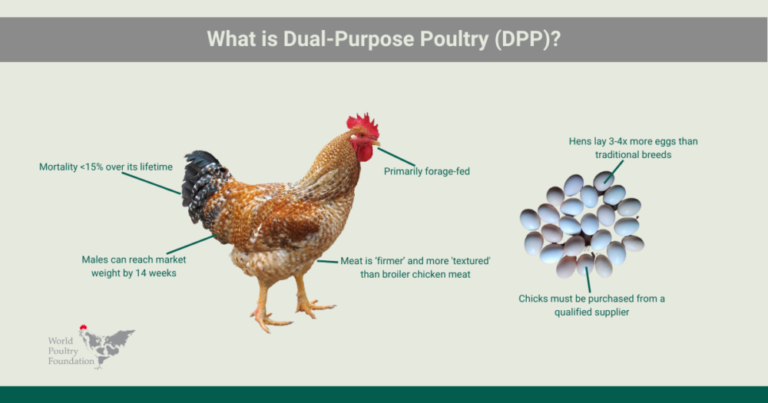Across Africa, an estimated 70% of small scale producers rear poultry (80% of whom are women). The majority rear traditional breeds which are more accessible in rural areas. Due to high mortality rates, expensive inputs, slower growth rates, and reduced egg production, traditional village breeds often result in low outputs, meaning small scale producers do not view poultry as a vehicle for increasing their income.
Our African Poultry Multiplication Initiative (APMI) works to address these challenges with a private sector approach to increase access to dual-purpose poultry (DPP), balanced feed, technical training, and efficient market linkages to realize a profitable poultry operation, with profits accruing at each link in the value chain.
While the birds themselves are only part of our program’s approach to developing the poultry value chain, they are arguably the most visible aspect of the program.
What is DPP?
DPP are scavenging breeds of chickens reared for both meat and egg production (dual-purpose). DPP have a few key attributes that make them particularly successful and profitable in rural areas:
- Suited to harsher conditions and can be primarily forage fed
- Males can reach market weight by 13 or 14 weeks, compared to 36 weeks up to one year for typical village birds
- Hens lay ~140 eggs, 3-4x that of a traditional village bird
- Mortality typically <5% in their first weeks of life (improving Brooder Unit profits)
- Mortality typically <15% over their lifetime, compared to > 40% for traditional village birds (improving Small Scale Producer profits)
- Meat is more textured and firmed than a broiler as it is more slower-growing than a broiler (better suited to local market preferences)

Benefits of DPP to small scale producers
Because of their low feed input costs and reduced mortality rates, DPP quickly become a more affordable and profitable breed than traditional village breeds, making them worth the investment. DPP also gain weight quickly (males) and have higher egg output (females), resulting in increased profits and household nutrition.
“It [chicken consumption] has changed a lot because before a month would pass without eating chicken, but now every week we eat one or two chickens because I have many to sell and eat. Because improved breeds [of] chickens grow very fast, it motivates [me] to keep many chickens so that I can increase my income and have it for meal[s].” – Tanzanian Farmer, 30 years old

DPP Distribution
The APMI supports linkages between private-sector producers and high-quality BUs to ensure DPP chicks are properly brooded, cared for, and vaccinated. DPP cannot be self-hatched by farmers and perform best when reared by specialized Brooder Units (BUs) through the first four weeks of life. This model greatly improves the quality of birds sold to small scale producers, improving outcomes and reducing mortality rates. The BU model also provides lucrative entrepreneurship opportunities and supports a larger distribution footprint into rural, hard-to-reach areas.
APMI Program Results
Since the APMI program began in 2017, we have supported the distribution of 97.5 million day old chicks, registered over 13,000 new BUs, and reached an estimated 2.3 million small scale producers in Nigeria, Tanzania, and Zimbabwe. Small scale producers and BUs, raising DPP, are experiencing:
- Higher quality birds geared towards local preferences
- Improved poultry productivity, through lower mortality, improved egg production, faster bird growth without need for expensive feed inputs
- Improved household income, through the sale of chickens and eggs
- Improved household nutrition, through the consumption of chickens and eggs
- Improved female engagement in the poultry value chains>>potential for women’s empowerment outcomes to improve
World Poultry Foundation Team
CATEGORY
LOCATION